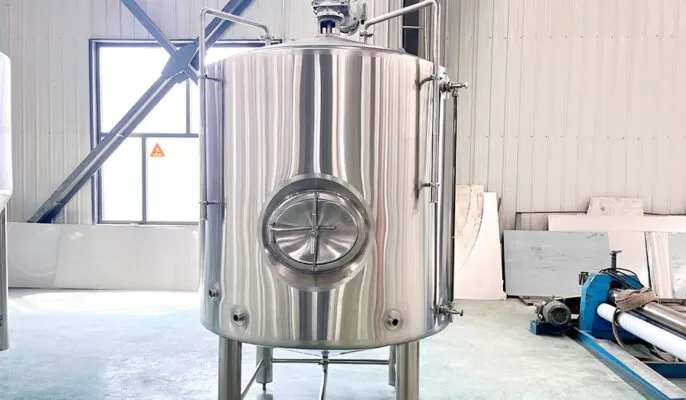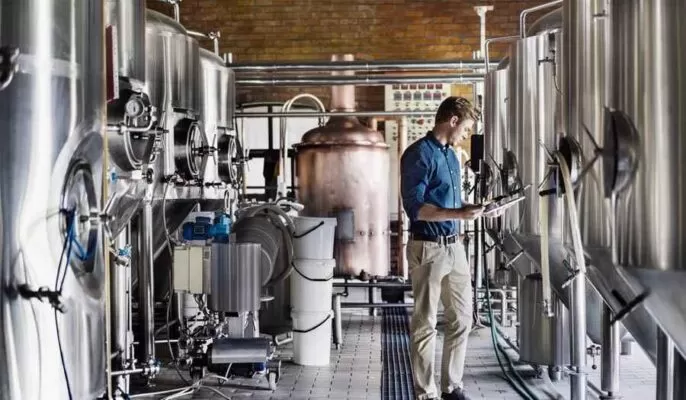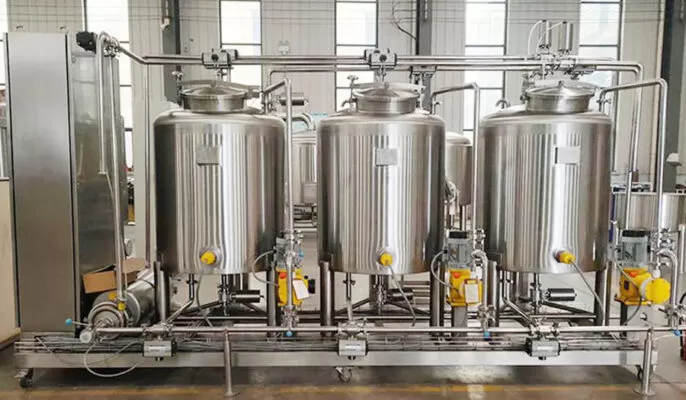Brewing beer on a 1000 liter system allows craft brewers to increase production while maintaining quality, consistency, and flavor control. This guide provides an overview of 1000 liter brewery setups from mash tuns, brew kettles, fermenters, brite tanks, and other accessories to help determine the right system for your brewery goals.
Overview of 1000 liter brewing equipment
1000 liter brewing equipment enables midsized commercial beer production batches. Key components include:
- Mash tun – Mixes grist with hot water for mash process. 1000 liter tuns allow all-grain mashing.
- Lauter tun – Separates sweet wort from spent grains after mash.
- Brew kettle – Boils wort with hops for hopped wort. 1000 liter kettles facilitate rolling boils.
- Whirlpool – Settles trub and coagulated proteins after boil.
- Fermenter – Ferments beer from hopped wort. Multiple 1000 liter fermenters build capacity.
- Brite tank – Clarifies and carbonates beer for serving.
- Glycol chiller – Cools wort quickly for yeast pitching. Maintains fermentation temp.
- Heat exchanger – Rapids cools boiled wort down to fermentation temperature.
- Piping – Transfers liquids between vessels. Sloped for drainage.
- Controls – Automated brewing process control and monitoring system.
With a 4 vessel brewhouse and fermentation cellar, 1000 liter batches can produce 3000-4000 barrels annually for packaging and distribution. Larger batches compared to pilot systems provide economies of scale.
Brewing Equipment Sizing Guide
This table provides a general sizing reference for key equipment at 1000 liter batch sizes:
| Equipment | Size Parameters |
|---|---|
| Mash tun | 1200-1500 L |
| Lauter tun | 1200-1500 L |
| Brew kettle | 1200-1500 L |
| Whirlpool | 500-1000 L |
| Fermenters | 1000 L each |
| Brite tanks | 1000 L each |
| Glycol chiller | 10-20 bbls capacity |
| Heat exchanger | 1000 L/hr |
| Piping | 2-3″ diameter |
1000 Liter Brewing Equipment Characteristics
Key traits of 1000 liter professional brewhouse components include:
- All-grain mashing capacity with sparge liquor heating
- Active boiling for hop isomerization and protein coagulation
- Sanitary stainless steel material construction
- Automated sensors and process controls
- Electric, gas, or steam heating options
- ASME certification for pressurized vessels
- Slope or cone bottom tanks for complete drainage
- Legs or casters for freestanding equipment placement
- Integrated cooling jackets, coils, or glycol loop connections
- CIP spray balls and ports for cleaning in place
- Custom brewery design and layout available

Applications of 1000 Liter Brewing Systems
1000 liter breweries enable the following production applications:
Brewery Scale and Scope
- Mid-sized brewpub or microbrewery operations
- Regional brewery distribution model
- Scaled starter system for expanding craft brewers
- Pilot batches for lager, ale, and specialty beers
- Flexible equipment for experimental small batch recipes
Production Volumes and Capacity
- Individual batches: 1000 liters (26.4 gallons)
- Production: Up to 3000-4000 barrels annually
- Fermentation capacity: Up to 16,000 L with multiple tanks
- Brite tank capacity: Up to 16,000 L for storage
Packaging Format Support
- Draft dispensing for brewpubs
- Bottling line interface for bottles
- Canning line interface for cans
- Keg filling and cleaning
This system size facilitates packaging beer in a variety of formats from draft to bottles and cans for retail sales.
Beverage Styles Produced
- Ales – IPA, pale ale, wheat ale, blonde ale, brown ale, etc.
- Lagers – pilsner, bock, Oktoberfest, helles, etc.
- Specialty beers – fruit, spiced, smoked, sour, Belgian, etc.
The flexibility supports small batch recipes for new craft beer creations.
Brewing System Design Specifications
Properly designed 1000 liter brewing equipment conforms to the following specifications:
Equipment Standards
- Brewers Association design and engineering standards
- ASME pressure vessel certification
- UL/ETL electrical safety listing
- NSF sanitation compliance
- 3A sanitary standard construction
Material and Components
- Stainless steel material – grade 304 or 316
- Sanitary welds – avoid cracks for cleaning
- Tri-clamp fittings – tool-less gasket seals
- Slope or cone bottom tanks – facilitate drainage
- Smooth interior finish – reduces adherence
- Food-grade gaskets, seals, insulation
Dimensions and Capacities
| Equipment | Diameter | Height | Volume |
|---|---|---|---|
| Mash Tun | 42-48′′ | 48-60′′ | 1200-1500 L |
| Lauter Tun | 42-48′′ | 48-60′′ | 1200-1500 L |
| Brew Kettle | 42-48′′ | 60-72′′ | 1200-1500 L |
| Fermenters | 36-42′′ | 72-84′′ | 1000 L |
| Brite Tanks | 36-42′′ | 48-72′′ | 1000 L |
Dimensions facilitate ergonomic operations and small brewhouse footprint.
Temperature and Pressure Ranges
- Mash tun: Max temperature 160°F. Atmospheric pressure.
- Lauter tun: Max temperature 160°F. Atmospheric pressure.
- Brew kettle: Max temperature 212°F. 15 psi working pressure.
- Fermenter: Max temperature 80°F. 15 psi working pressure.
- Brite tank: Max carbonation pressure 30 psi. Max temperature 40°F.
Heat and Power
- Electric heating elements in brew kettle and hot liquor tank
- Steam heating coils and injectors
- Gas burner heat systems
- Refrigeration lines or glycol cooling
- Single or three phase power configurations
- Process control automation
Major Suppliers of 1000 Liter Brewing Systems
Many brewhouse manufacturers offer 1000 liter brewing equipment and components:
| Company | Location | Offerings | Price Range |
|---|---|---|---|
| Specific Mechanical | Victoria, Canada | Brewhouses, fermentation | $$$ |
| Premier Stainless | Escondido, CA, USA | Brewhouses, tanks, accessories | $$ |
| Ss Brewtech | Stowe, VT, USA | Brewhouse, fermenters, brite tanks | $$ |
| Spike Brewing | Clinton Township, MI, USA | Kettles, fermenters, brite tanks, accessories | $ |
| Stout Tanks | Portland, OR, USA | Fermenters, brite tanks, process piping | $$ |
| JV Northwest | Canby, OR, USA | Glycol chillers, heat exchangers, cooling systems | $$ |
$$$ = Premium commercial systems at higher budgets $$ = Mid-range commercial systems $ = Economy starter commercial systems
Factors in Choosing a Supplier
Consider these factors when selecting brewing system manufacturers:
- Equipment quality and durability
- Customization and flexibility
- Responsive customer service
- Experience with systems of similar size
- Familiarity with regional brewing methods
- Installation services offered
- Availability of replacements parts
- Budget and pricing
- Production schedule and lead time
It is wise to get multiple quotes before selecting a vendor for 1000 liter brewhouse equipment.

Installation of 1000 Liter Brewing Systems
Proper installation of 1000 liter commercial brewing equipment enables efficient operation.
Utilities and Infrastructure
- Sufficient electrical service for heating elements and controls
- Water lines sized appropriately for volume of brewing
- Drainage for spent liquids and cleaning
- Compressed air lines for automation actuation
- Ventilation system capacity for steam release
- Glycol or refrigeration lines for cooling
- Space for piping runs and clearances
Equipment Positioning
- Level placement on concrete floor or frame stands
- Working heights accessible for brewers
- Unsliced vessels for cleaning access
- Clearances for opening lids safely
- Support structures for elevated tanks
- Room for maintenance access all around
Connection Piping
- Slope pipes at least 1/100 grade for drainage
- Support pipes on stands or wall brackets
- Specify gaskets, unions, tri-clamps, and valves
- Insulate hot side vessels and piping
- Install sample ports and sight glasses
- Leak test piping before startup
Proper floor drainage and waste collection helps keep the brewery clean.
1000 Liter Brewery Operations
Day-to-day 1000 liter brewery operations involve the following:
Milling
- Inspect grain for quality
- Measure out grain bill with scale
- Crack grains with roller or hammer mill
- Collect milled grist in vessel for mashing
Mashing
- Fill mash tun with strike water to hit target temp
- Add grist to hit desired liquor to grist ratio
- Recirculate mash to maintain even temperature
- Hold mash rest temperatures for starch conversion
- Take pH and gravity measurements
Lautering
- Recirculate wort to clarify before sparge
- Slowly add sparge liquor for sugar extraction
- Control wort clarity and flow to lauter tun
- Collect sweet wort for boiling
Boiling and Whirlpool
- Bring wort to rolling boil for hop additions
- Adjust boil vigor to prevent boil overs
- Add hops per recipe schedule and timers
- Chill boiled wort below 180°F for whirlpool
- Knock out trub and coagulants with whirlpool action
Wort Cooling and Aeration
- Pass hot wort through heat exchanger
- Oxygenate chilled wort to saturation
- Verify OG, pH, clarity parameters
- Pitch selected yeast strain
Fermentation
- Maintain steady fermentation temperature
- Monitor gravity, pH, yeast health
- Bleed pressure as needed
- Add dry hops if required
- Evaluate taste and aroma
- Confirm complete attenuation and final gravity
Transfer and Carbonation
- Transfer beer to brite tank via pump or gravity
- Filtration optional prior to packaging
- Carbonate to desired volumes of CO2
- Crash cool brite tank for clarity
Packaging and Serving
- Bottle, keg or can using fillers
- Date code packaged product
- Apply proper tapping pressure on kegs
- Serve draft beer with proper glassware!
Regular equipment inspections, cleaning and sanitation are vital. Record keeping provides consistency between batches.
Maintenance of 1000 Liter Brewing Systems
To sustain quality beer production, 1000 liter brewing equipment requires regular maintenance:
- Daily cleaning – Clean vessels and pipes after each use to prevent growth of bacteria, mold and wild yeast. Use properCLEAN IN PLACE (CIP) procedures with detergents and hot water rinses.
- Weekly sanitation – Sanitize all equipment with chemicals like iodophor or cleaners containing chlorine. Ensure thorough penetration. Rinse thoroughly.
- Gasket inspection – Check condition of gaskets regularly. Replace worn or failed gaskets to prevent leaks or contamination. Lubricate gaskets occasionally with glycerine or food grade oils to prolong life.
- Monthly calibration – Calibrate sensors and measurement devices regularly for accuracy. This includes thermometers, pressure gauges, scales, automatic sensors, etc. Recalibrate or replace out of spec equipment.
- Annual tune ups – Have professionals inspect and tune up the brewhouse system annually. Check calibration and function of all sensors and meters. Verify heating elements fully functional. Inspect pipes and vessels thoroughly for any corrosion or pitting. Replace worn parts and gaskets. Update automation software if needed.
- Major maintenance – Schedule periodic major maintenance for the mash tun, brew kettle, whirlpool, fermenters, brite tanks and other vessels based on total brewing volume each year or every 3000-5000 batches. Vessels may need resurfacing or replacement if badly corroded or pitted. Update heating elements, fittings, valves, insulation and gaskets as needed. Automation may need hardware or software updates.
Following standard maintenance and hygiene procedures helps sustain quality and prolongs equipment lifespan. Track maintenance activities for each vessel.
How to Choose a 1000 Liter Brewhouse Supplier
Selecting the right brewhouse equipment supplier is key to getting a 1000 liter brewing system that meets quality, reliability and budget needs. Here are tips for evaluating and choosing manufacturers:
Assess reputation – Research brewing industry forums and talk to other local brewers about suppliers. Look for recommendations and experienced companies.
Verify capabilities – Ensure the supplier has expertise building complete brewhouse systems at the 1000 liter commercial scale, not just individual components.
Compare build quality – Inspect sample equipment in person from each prospective vendor. Check welds, finishes, fittings and material quality up close.
Review flexibility – Determine how customizable the system components are for layout and options. Look for modular vs custom build approaches.
Consider customization – Evaluate if the supplier provides engineering services to design systems around your space, workflow and brewing methods.
Check certifications – Make sure the vendor meets ASME, UL, 3A and other standards for vessel fabrication and system integration.
Confirm lead time – Get commitments on equipment production and delivery schedules. Understand impacts of any delays.
Compare pricing – Get formal quotes from multiple suppliers outlining all equipment, installation services and other deliverables. Review line by line.
Verify service policies – Ask about startup support services, training, warranties, and post-sale technical assistance provided.
Request references – Talk to other brewers using systems from the company about their experiences. Get candid feedback.
Taking time to thoroughly evaluate 1000 liter brewhouse suppliers reduces project risk and leads to better brewing outcomes.
Pros and Cons of 1000 Liter Brewing Systems
1000 liter commercial brewing systems offer benefits as well as drawbacks:
Benefits of 1000 Liter Systems
- Facilitates expansion for start up craft brewers
- Enables bottling and canning packaging lines
- Allows wider production volume ranges
- Supports specialty small batch recipes
- Provides mid-size system affordability
- Less manual labor compared to pilot systems
- Capable of lagers, ales and unique styles
- Flexible for brewpub or distributed models
Challenges of 1000 Liter Systems
- Still manual work intensive vs fully automated
- Additional technical skill required
- Margin for error lower than homebrew scale
- More intensive maintenance than smaller systems
- Upgrades likely still needed for very high growth
- Difficult to match large brewery efficiency
- Cannot rival mass production volumes
Understanding this balance between capabilities and limitations ensures the system matches business objectives. Talk to existing users about pros and cons before committing.

FAQ
Here are answers to some common questions brewers have about 1000 liter brewhouse equipment:
What types of breweries use 1000 liter systems?
Mid-sized brewpubs, taprooms, and microbreweries use 1000 liter systems. They enable scaling up production while retaining hands-on techniques. They offer capacities between pilot systems and large regional breweries.
What materials are used to build 1000 liter brewhouses?
Commercial brewing systems primarily use stainless steel for hygiene and durability – usually grade 304 or 316. Vessels receive mirror polish finishing. Tri-clamp fittings simplify connections. Food-grade gaskets seal all joints.
What heating options exist for 1000 liter kettles?
Gas fired burners, electric heating elements or steam injectors can all effectively heat kettles at this scale. Electric systems provide precision control via automation. Gas burners enable very strong boils. Steam injectors require a boiler.
How many fermenters and brite tanks support a 1000 liter system?
A starter 1000 liter brewery would want 4 to 6 fermenters and 2 to 4 brite tanks as a minimum. Lagering requires more tanks. Additional units build capacity. Glycol jackets are common.
How are 1000 liter brewhouses automated?
Brewing process automation includes electronic measurement of temperatures, densities, flow, valves and motors. Software integrates sensors, relays, switches and other instrumentation. Users interface on touchscreen HMIs.
What goes into installing and starting up a 1000 liter system?
Experienced technicians assemble the equipment, connecting vessels via plumbing and wiring automation components. They configure control settings and test the system before validating it ready for brewing. Training is key.
How can 1000 liter breweries scale up production?
Starting with a 4 vessel, 1000 liter system provides room to grow. Additional fermenters, brite tanks, filtration and packaging equipment can expand capacity. Upgrading to larger brewhouse vessels and more automation enables very high volumes.




